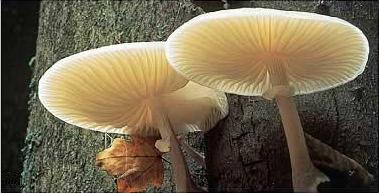Fascinated by Fungi
Interview with
With over 3000 species of mushrooms and toadstools in the UK alone, we figured there had to be more to them than just a bit of mould; Alison Ashby, from the  Department of Plant Sciences at Cambridge University, introduced Chris Smith to the microscopic world of fungi...
Department of Plant Sciences at Cambridge University, introduced Chris Smith to the microscopic world of fungi...
Chris - For the uninitiated, what actually is a fungus?
Ali - Fungi are a very diverse group of organisms. There are over 1.5 million different species of fungi. They're split into roughly 5 different phyla, so 5 different groups and they do some amazing things for us and for our environment. But the basic structure of a fungal cell is actually fairly similar to a plant and animal cell. It has a membrane just like an animal cell does, and it has a cell wall just like a plant cell does. But the cell wall is composed chitin rather than cellulose, which of course a plant cell wall is composed of, and of course, fungi don't contain chloroplasts, so they can't photosynthesise.
Chris - Does that mean they depend on plants then to get their energy? How do they survive?
Ali - They're heterotrophic organisms. So basically, what they do is they break down dead organic matter. They are the world's best recyclers and what they do is they send out fine filaments of hyphae which group together to form the main body of a filamentous fungus that's the mycelium. And the mycelium ramifies through just about every habitat on this planet, producing extracellular enzymes which are released into the environment, around the mycelium and they're then used to obviously break down large organic molecules into smaller building blocks that can be used, not only by the fungus, but also by other organisms within the ecosystem.
Chris - So, the fungus secretes this digestive juice, the goodies get taken up into the fungus and it then carts it off, grows more fungus but then also - I was reading, it almost then uses it to barter with other organisms to trade.
Ali - That's right. One of the amazing things that fungi do is they form partnerships with plants. These partnerships are called mycorrhizas. There are several different types of mycorrhizas but probably, the two most dominant types are the ectomycorrhizas and they form between the basidiomycete group of fungi and trees and shrubs within the woodland habitat.
We also have the AM mycorrhizae, the arbuscular mycorrhizae and they actually are a partnership between glomeromycota and up to 80% of plants species, mainly crop plants and horticultural plants. Basically, what happens with an AM mycorrhizal association is the fungus will actually penetrate the cells of the cortex of the root. And there's basically a trade-off. The fungus will send out its mycelial strands out into the environment and into areas where it can capture minerals like nitrogen and phosphorus and water, and translocate those back to the plants where they're taken up and used for plant growth.
Chris - What does the plant pay for this valuable mineral?
Ali - In return of course, the plant provides photosynthate, carbon compounds that it's made during photosynthesis. But it's really very interesting because plants can associate with many more than just one mycorrhizae. They can associate with a whole group of mycorrhizae. Similarly, mycorrhizas can build associations with a number of different plants and there's a trade-off. A plant will decide whether or not it's going to give a lot of carbon to its mycorrhizal partner and it's all dependent on how much phosphorus and nitrogen the mycorrhizal partner will give in return. In other words, it's sort of a two-way biological marketplace where both partners are contributing products and services, and both are rewarded for success.
Chris - Do other signals potentially go through that network apart from just, "I give you some sugar. You give me back some phosphorus. That's very nice." What about if I'm sensing danger in my neck of the woods? Can I send a signal via you to Hannah to say, "Watch out!"?
Ali - Absolutely. We found some very interesting things recently with common mycorrhizal networks and that is that if a plant that has a common mycorrhizal network is challenged by a pathogen then it can actually send info-chemical signals through the common mycorrhizal network to neighbouring plants. And this allows those plants to become primed for resistance. So, they build up a sort of immunity and it's a little bit like the innate immune system in animals. So, it becomes primed and ready, and able to defend itself, should it be challenged.
Hannah - But are fungi always the good guys?
Ali - Fungi do some amazing things for us and they make the world tick. But of course, they can be rotters. They do do bad things too. In fact, 70% of plant diseases are caused by fungi and a number of fungi also produce secondary metabolites that have toxic effects, particularly if humans consume the mushroom.










Comments
Add a comment